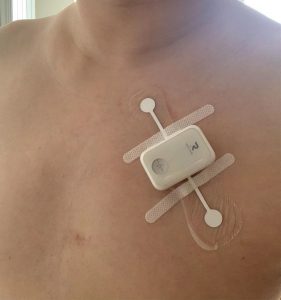One third of fatal heart attack and stroke patients are under 70. Engineers Australia member Dr Zihuai Lin MIEAust is working on a wearable smart patch that could keep them safe.
Globally, cardiovascular diseases claim about 17.9 million lives each year. Over four fifths of these deaths are due to heart attacks and strokes, and some people die without a diagnosed heart condition.
“The number one killer in the world is cardiovascular disease,” Lin told create, adding that it doesn’t just affect older people. One of Lin’s 50-year-old classmates died last year of a sudden stroke while playing basketball.
Lin, an electrical engineer and Senior Lecturer at the University of Sydney’s School of Electrical and Information Systems Engineering, is part of a team developing a system that combines a small, wearable electrocardiogram (ECG) patch with a mobile phone app, the Internet of Things (IoT), and cloud-based artificial intelligence (AI) to more easily detect and monitor heart disease.
“We’re using our technology to help people’s health,” he said.
Digital twin of the heart
The system Lin is working on uses a cloud-based digital twin of the human heart to allow automatic diagnosis of cardiovascular disease.
“We can generate a digital heart in the cloud, based on the data we collect from different people,” he explained.
The system can also use signals from the wearable ECG patch to analyse patients’ sleep quality, or detect epilepsy.
Traditionally, hospitals use stationary equipment to perform ECGs, but they only monitor the heart for a short time. To collect more data, patients can be asked to wear a Holter device at home over a 24-hour period. This involves a number of plastic stickers on the chest connected by wires to a monitor worn on the hip.
“It’s very inconvenient and bulky, and you can’t take a bath,” Lin said.
To get around this, Lin’s team have developed a single wireless ECG patch that can be fixed to the chest. The patch connects to a mobile phone app via Bluetooth, and from there, the patient can upload the ECG data to the cloud.
“We can see the ECG signal in real time, and detect whether it is healthy or not in a short time,” Lin said, adding that in initial trials in Chinese hospitals, the system has shown 97 per cent to 98 per cent accuracy.
The system software automatically generates a report based on the ECG data, which is checked by a cardiologist before being sent to the patient.
“The algorithm can detect very subtle patterns and help the doctor’s analysis,” he said.
Data on the move
When designing the wearable ECG patch, Lin said patients’ comfort and convenience were the major considerations. The prototype is 8 mm thick, weighs 13 g, is waterproof to allow patients to take showers or exercise, and can be worn continuously for up to seven days.

But allowing patients more freedom created an engineering challenge. While data signals collected by hospital equipment are generally very clean, that’s not the case when people are moving around or splashing in the tub.
To solve this issue, the team developed AI algorithms to do data cleaning.
“The signal we collect is a bit noisy,” Lin said.
“We used wavelet transform to decompose signals into different frequencies and neural networks to improve the accuracy of diagnosis.”
Within the next two years, Lin’s team will collaborate with Sydney’s Westmead Hospital to trial the system with their patients, with the aim of collecting ECG signals from 30,000 people.
While this stage of data collection will focus on patients over 75 years old, Lin said the patches could also be worn by younger people. His team is also developing a smart patch for pregnant mothers that monitors the heart of an unborn child.
Smarter patches to come
In the next six months, Lin’s team plans to upgrade the wearable ECG patch with an AI chip to give it data processing capability.
The next-generation ECG patch will not need a phone for storing and uploading data. It will also be able to operate in areas without wireless connectivity, as it will store data in the chip, to be uploaded to the cloud later.
“So far, there is no similar device in the world,” Lin said.
“This will make it very convenient for older people who are not familiar with smartphone technology.”
The main application for the AI-enabled ECG patch will be to provide real-time monitoring and analysis to prevent cardiovascular emergencies such as heart attacks or strokes — particularly during strenuous exercise or sports.
“In real time, it can give you an alarm to let you know to take a rest,” Lin added.




Excellent work
Interesting and timely research. I would love to read more about this project. My concern will be the quality of the signal given the exteded usage of the wearable patch. Previous studies conformed the signal from the wet electrodes deteriorate over time.